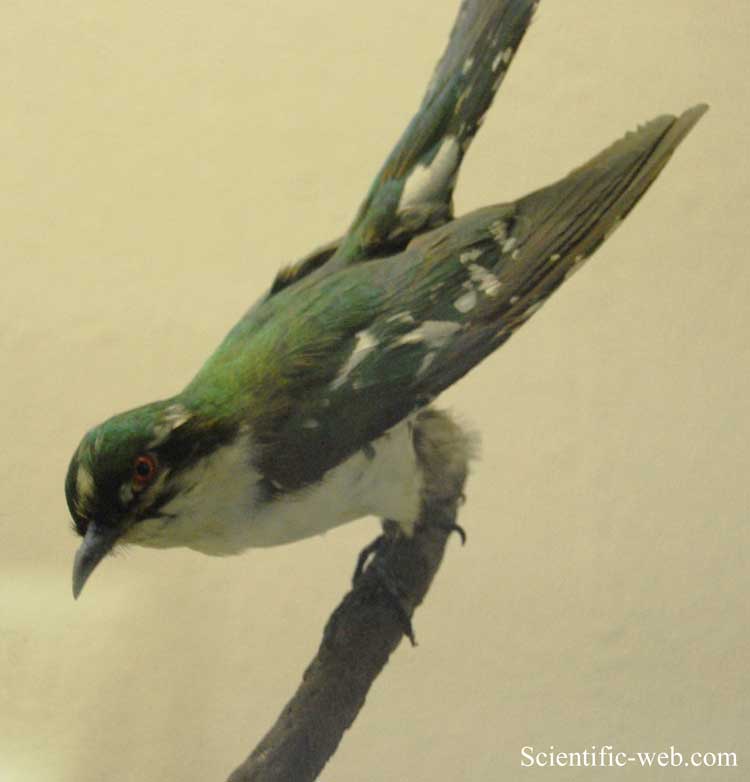
Chrysococcyx cupreus, Photo: Michael Lahanas
Subregnum: Eumetazoa
Cladus: Bilateria
Cladus: Nephrozoa
Superphylum: Deuterostomia
Phylum: Chordata
Subphylum: Vertebrata
Infraphylum: Gnathostomata
Megaclassis: Osteichthyes
Cladus: Sarcopterygii
Cladus: Rhipidistia
Cladus: Tetrapodomorpha
Cladus: Eotetrapodiformes
Cladus: Elpistostegalia
Superclassis: Tetrapoda
Cladus: Reptiliomorpha
Cladus: Amniota
Classis: Reptilia
Cladus: Eureptilia
Cladus: Romeriida
Subclassis: Diapsida
Cladus: Sauria
Infraclassis: Archosauromorpha
Cladus: Crurotarsi
Divisio: Archosauria
Cladus: Avemetatarsalia
Cladus: Ornithodira
Subtaxon: Dinosauromorpha
Cladus: Dinosauriformes
Cladus: Dracohors
Cladus: Dinosauria
Ordo: Saurischia
Cladus: Eusaurischia
Subordo: Theropoda
Cladus: Neotheropoda
Cladus: Averostra
Cladus: Tetanurae
Cladus: Avetheropoda
Cladus: Coelurosauria
Cladus: Tyrannoraptora
Cladus: Maniraptoromorpha
Cladus: Maniraptoriformes
Cladus: Maniraptora
Cladus: Pennaraptora
Cladus: Paraves
Cladus: Eumaniraptora
Cladus: Avialae
Infraclassis: Aves
Cladus: Euavialae
Cladus: Avebrevicauda
Cladus: Pygostylia
Cladus: Ornithothoraces
Cladus: Ornithuromorpha
Cladus: Carinatae
Parvclassis: Neornithes
Cohors: Neognathae
Cladus: Neoaves
Ordo: Cuculiformes
Familia: Cuculidae
Genus: Chrysococcyx
Species: Chrysococcyx cupreus
Subspecies: C. c. cupreus - C. c. insularum - C. c. intermedius
Name
Chrysococcyx cupreus (Shaw, 1792)
References
Musei Leveriani explicatio, anglica et latina. 1 p. 157
Vernacular names
বাংলা: আফ্রিকান শ্যামাপাপিয়া
čeština: Kukačka žlutobřichá
Türkçe: Afrika zümrüt guguğu
The African emerald cuckoo (Chrysococcyx cupreus) is a species of cuckoo that is native to Africa.
Taxonomy and phylogeny
As a member of the family Cuculidae, the African emerald cuckoo is an Old World cuckoo. There are four subspecies, namely C. c. cupreus, C. c. sharpei, C. c. intermedius, and C. c. insularum.[2][3]
C. c. cupreus: Africa south of the Sahara
C. c. intermedius: Bioko (Gulf of Guinea)
C. c. insularum: São Tomé, Príncipe, and Annobón (Gulf of Guinea)
Distribution
Its range covers most of sub-Saharan Africa, including Angola, Botswana, Burundi, Cameroon, Central African Republic, Republic of the Congo, DRC, Ivory Coast, Equatorial Guinea, Eritrea, Eswatini, Ethiopia, Gabon, Gambia, Ghana, Guinea, Guinea-Bissau, Kenya, Liberia, Malawi, Mali, Mozambique, Namibia, Nigeria, Rwanda, São Tomé and Príncipe, Senegal, Sierra Leone, South Africa, South Sudan, Tanzania, Togo, Uganda, Zambia, and Zimbabwe.
Description
The African emerald cuckoo is sexually dimorphic. The males have a green back and head with a yellow breast. Females are barred green and brown on their backs and green and white on their breasts. The African emerald cuckoo can also be identified by its call, a four-note whistle with the mnemonic device of “Hello Ju-dy.” [4]
Diet
The cuckoo's diet consists mainly of insects like caterpillars and ants.[5] The diet can be supplemented with some fruit, and the African emerald cuckoo often forages in the middle and top layers of the canopy.[6]
Breeding
Chrysococcyx cupreus in a spawn of Anabathmis newtonii - MHNT
Like most cuckoos, the African emerald cuckoo is a brood parasite. Female African emerald cuckoos lay eggs in the nests of other bird species. A female cuckoo can lay between 19 and 25 eggs on average per breeding season.[7] The breeding season occurs during the rainy seasons, generally during the months between September and March.[4] Even though the cuckoos do not need territory to feed fledglings, male African emerald cuckoos still maintain territories to display themselves to potential mates.[4]
Conservation status and threats
The cuckoo's distribution is 11,400,000 km (7,100,000 mi)[4] across sub-Saharan Africa, and subsequently the species is not in any immediate threat of decline.[8] However, there is some concern about habitat reduction and fragmentation of riparian areas and lowland forests in the upcoming years.[6]
Folklore
In the Zigula language its call has been rendered as ziwkulwa tuoge, ("let's go and bathe"). In Zulu it is known as ubantwanyana, or "little children", which suggests the song Bantwanyana! ning'endi!, or "Little children, don't get married!".[9] In Xhosa it is mostly known as intananja,[5] but its call is also rendered as ziph' iintombi?, meaning "where are the girls?"[9] In Afrikaans, it is known as the mooimeisie, or "pretty girl".[10]
References
BirdLife International. (2017) [amended version of 2016 assessment]. "Chrysococcyx cupreus". IUCN Red List of Threatened Species. 2017: e.T22684021A111721716. doi:10.2305/IUCN.UK.2017-1.RLTS.T22684021A111721716.en. Retrieved 24 October 2020.
"African Emerald Cuckoo Chrysococcyx cupreus (Shaw, 1792)". avibase.bsc-eoc.org. Avibase: The World Bird Database. Retrieved 12 October 2015.
Payne, R. (2021). Del Hoyo, Josep; Elliott, Andrew; Sargatal, Jordi; Christie, David; De Juana, Eduardo (eds.). "African Emerald Cuckoo (Chrysococcyx cupreus)". Handbook of the Birds of the World Alive. Lynx Edicions, Barcelona. doi:10.2173/bow.afecuc1.01.1. Retrieved 22 December 2016.
Payne, R (2021). "African Emerald Cuckoo (Chrysococcyx cupreus)". In Del Hoyo, Josep; Elliott, Andrew; Sargatal, Jordi; Christie, David; De Juana, Eduardo (eds.). Birds of the World. doi:10.2173/bow.afecuc1.01.1.
Johnson, Sibylle, African Emerald Cuckoo
"Chrysococcyx cupreus (African emerald cuckoo , Emerald cuckoo)".
Payne, Robert B. (14 July 2005). The Cuckoos. ISBN 9780191513558.
Ekstrom, J. "African Emerald Cuckoo Chrysococcyx cupreus".
Godfrey, Rev. Robert (1941). Birdlore of the Eastern Cape Province (Bantu Studies Monograph Series, No. 2) (PDF). Johannesburg: Witwatersrand University Press. p. 57.
Sinclair, Ian (31 July 1995). Voëls van Suider-Afrika. Struik. ISBN 1-86825-197-7.
Retrieved from "http://en.wikipedia.org/"
All text is available under the terms of the GNU Free Documentation License

_male.jpg/512px-African_emerald_cuckoo_(Chrysococcyx_cupreus)_male.jpg)
